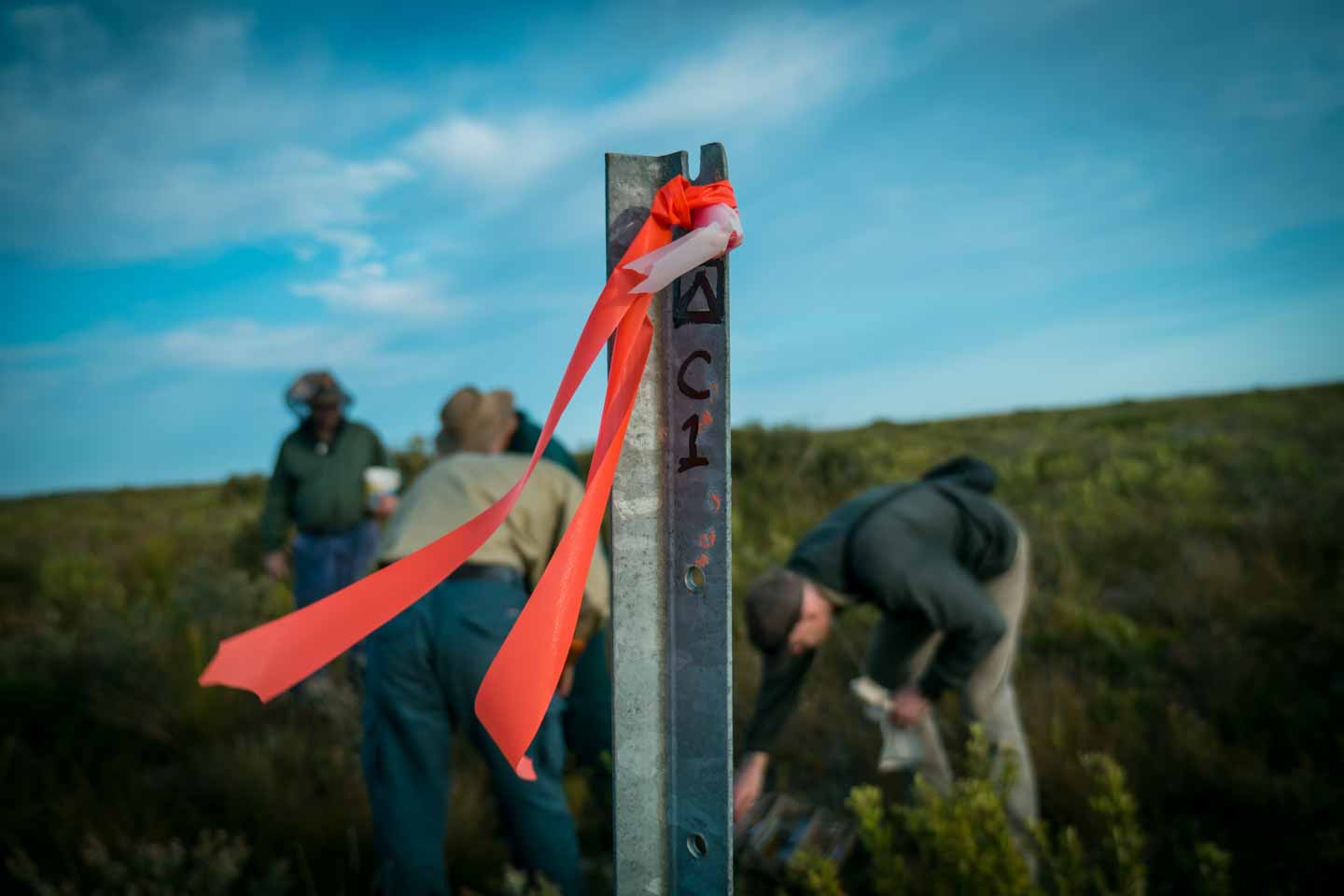
We were about to leave Esperance for Le Grand National Park when a local photographer told us about Cape Arid. She said it's like Le Grand but without all the people. We were sold straight away. Instead of tourists we ran into a group of researchers from Parks and Wildlife WA. I volunteered to help and had a blast. Stunning wildlife, gorgeous white beaches and crystal clear turquoise water with no one to share but my beloved partner and a few scientists willing to share their knowledge. How much better can it get?

It takes a little more effort to get into Cape Arid than it would to get to Le Grand. Once you past the turn off to Le Grand it's another 50km and the road turns from paved to gravel. We took a few detours to have a look at the beautiful beaches in-between the two parks and ended up on some pretty narrow and sandy 4WD tracks. Once more we had to deflate the tyres. We thought of spending the first night at a place called Thomas Fishery but got bugged twice on the way in. To be honest, I was pretty glad we made it back to the main track and we decided to sleep at Seal Creek, a place you might even be able to reach with a 2WD. It's a free camp and we were surprised to find a drop toilet and a gas BBQ.

There were only a few tents at the campground and it turned out they all belonged to a group of researchers and volunteers from the Department of Parks and Wildlife Western Australia. They came to Cape Arid National Park to carry out hearings for the rare and protected Western Ground Parrot. Further they had set a number of different traps to determine the type, diversity and growth of the local fauna. After a quick chat I offered my help and to my surprise was able to join the team on their next early morning routine.

The following day I was hitching a ride with Esperance's district nature conservation coordinator Stephen Butler. We left camp at first daylight to met up with another group that had left earlier to go out on hearings for the Western Ground Parrot. It is one of the rarest parrots in the world and you are more likely to hear it than to spot it. The Western Ground Parrot is unique to Western Australia and there are less than 140 individuals left. Visit the website of the Friends of the Western Ground Parrot to find out more about this unique bird and support their effort to save this species from extinction.

I was pretty excited to join the fieldwork and was trying not to fire to many questions at poor Steve. He took it with a smile and was more than willing to give me a deeper insight into his work. His duties and responsibilities are pretty versatile, ranging from office work, awareness training, coordination and communication, to trips like this one.

We split up in smaller groups to check the traps. The first one we found had caught an Ash Grey Mice and Steve carefully removed it from the trap to take its weight and measures. The little red mark on the tail indicates that the mouse had been trapped before. So either this little bugger was just unlucky or it could not resist the peanut butter oat mix used as bait.

In order to get some significant data the researches had repeatedly set a rectangular array of about 50 traps. To cover the biodiversity of Cape Arid National Park they are using 3 different types of traps. The majority are little cages with a trap-door, followed by buried buckets and funnel traps. Each set of traps is marked with a permanent pole and an encoded description of the traps being used.

We slowly made our way throughout the scrub. On an average every second trap had caught something. The animals were retrieved with great caution and carefully examined. I have to say that I am generally not a big fan of trapping animals, but the scientists really gave their best to make it as pleasant as possible for all creatures being caught. All traps were checked on a regular basis to avoid long captivity and the buckets were filled with branches and leaves to serve as a hiddeway.

A few years ago Cape Arid National Park was afflicted with bush fires and the scientists were glad to see some Bandicoots moving back into this area. Altogether we found two this morning and a few more the next morning. This is already a lot more than the group had caught last time and it really put a smile on their faces.

The Bandicoot was carefully measured and ringed to keep track of him. The whole procedure did not take longer than a few minutes and than he was free to go straying around again. We had seen a few Bandicoots at Cosy Corner further down the coast but getting this close to such a cute animal was really special.

Without the orientation of the others I would probably not have found a single pole, let alone any traps. The poles seem to be quiet obvious when you are standing right in front of them, but then they just blend in with the rest of the scrub. If you don't know in which cardinal direction you have to head to find the next one you are more than likely to miss it.

Here's another Bandicoot getting his head measured. Many of the animals we caught that day were quite small and young and therefor offsprings that were probably born in Cape Arid National Park. To the researchers this was a very good sign, showing that populations are growing again. The recent fire had killed and scared a lot of animals but now they are not only coming back but already reproducing.

The buckets are a pretty simple way to trap animals. They are buried with their opening flush with the ground and little nets are leading the animals straight into them. Unfortunately some of the trapped individuals don't get along to well. The day before a few Bull Ants had fallen into the bucket and sad but true killed a Honey Possum that had already been inside. The scientists decided to close the trap to prevent a recurring of this accident.

Apparently Ash Grey Mice are doing a good job in fighting Bull Ants. We found this one in a trap with two Honey Possums and 4 Bull Ants. All Ants were dead and the Possums still alive. Nevertheless the researchers decided to close this trap, too. You never know what's going to happen the next night.
To be honest I never heard about Honey Possums before we came to Cape Arid National Park. But once I knew they exist I wanted to see them. Fortunately enough I got to see quite a few doing my volunteering work for Parks and Wildlife Western Australia. It's a tiny Australian marsupial and the only one feeding from nectar only. The video shows a grown up male Honey Possum. After being in the trap for up to a whole night the researches coddled up the Honey Possums with some nectar to make up for the time not being able to feed. I think Honey Possums are among the cutest animals I have ever seen. Have a look at the little tong it's using to suck the nectar. Later in the video it looks like it does not want to let go of the glass with it's delicious content. We also uploaded a YouTube version of this video for you to share. Like with all our other Youtube videos, watching the advertisement will help to support us.

I enjoyed every single second I was able to spend with the staff and volunteers from Parks and Wildlife. Thank you so much for having me with you and giving me the chance to get a better understanding of how research works. It was cute to see the animals so close and to get a first hand experience on how well they are treated. Parks and Wildlife Western Australia is doing a great job and I hope this little article will contribute to their reputation and public support.

For me volunteering for Parks and Wildlife was the highlight of our trip to Cape Arid National Park. but to serve justice to this outstanding place we have to mention a few more things. Cape Arid might not be as known as other parks, especially Le Grand National Park, but it is in no way inferior to them. I even think it is the far better pick. You will get to see the same crystal clear water and stunning landscape but definitely meet a lot less people. If pristine nature and off the track places are your thing, Cape Arid National Park should be your first choice visiting this area.

During our days in Cape Arid we spent a lot of time fishing. We caught a lot of herrings and for the first time ever a large squid. We had no phone reception so we had to come up with a recipe ourselves. We cooked the squid in olive oil, fresh tomatoes, chili and a lot of garlic. The result was mind-blowing. We still both think that this was one of the best meals we had on this trip. The squid had a lovely taste and the meat a tender texture far different from the fried calamary you get at fish and chips shops.

There are several 4WD tracks and beaches in Cape Arid National Park. You can easily spend a week without getting to know them all. We did not do much driving and rather went on foot to explore the beautiful area. From our camp it was only a 5 minute stroll to get to the closest beach to have a swim in the great clean water.

Like in Le Grand National Park the sand is whiter than white. It sounds strange, but the sand is even to white. It reflects the sunlight in such an intensive way that walking down the beach without sunglasses is almost impossible. Something we have experienced for the first time ever.

Cape Arid National Park is definitely among our favorite parks we have visited since we are in Australia. We had such a good time away from the stress and hassle of modern civilization. Be prepared to bring your own water and supplies, there's not much around but that's what you come for. The white beaches and turquoise water are breathtaking and if you don't mind being all to yourself there are not many places that can keep up with Cape Arid.

